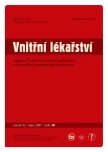Changes in lipid metabolism in patients in the active phase of Crohn’s disease
Authors:
V. Hrabovský 1; Z. Zadák 2; V. Bláha 3; R. Hyšpler 3; T. Karlík 4
Authors‘ workplace:
Metabolická JIP, vedoucí MUDr. Vladimír Hrabovský, interního oddělení FN Ostrava - Poruba, přednosta doc. MUDr. Arnošt Martínek, CSc.
1; Centrum pro vědu a výzkum Lékařské fakulty UK Hradec Králové, vedoucí prof. MUDr. Zdeněk Zadák, CSc.
2; Klinika gerontologická a metabolická Lékařské fakulty UK a FN Hradec Králové, přednosta prof. MUDr. Luboš Sobotka, CSc.
3; Ústav biochemie FN Ostrava - Poruba, přednosta prim. MUDr. Antonín Pohlídal, Ph. D.
4
Published in:
Vnitř Lék 2007; 53(10): 1035-1039
Category:
Original Contributions
Overview
Introduction:
Crohn’s disease (CD) in its active period is accompanied by a decreased food intake and deterioration in water, mineral and metabolic balance. Lipid metabolism is known to be altered in many acute diseases, and hypocholesterolemia is a serious negative prognostic indicator. The causes of decreased serum cholesterol concentration are multiple. Simultaneous affection of both cholesterol synthesis and absorption has been reported in many sources. The changes in both the above processes can be quantified with the use of specific indicators of synthesis (cholesterol level) and absorption (sitosterol and campesterol levels).
Objective:
The objective of the study was to demonstrate changes in lipid metabolism in patients with active Crohn’s disease, and to find out to what extent the above phenomenon is influenced by the affection of the process of cholesterol synthesis and/or absorption in the case of detected hypocholesterolemia.
Material and methods:
Total serum cholesterol, LDL- and HDL-cholesterol and triglyceride levels were measured on the 3rd, 14th and 28th day from admission in addition to admission analyses in 24 patients with acute manifestation of CD (CDAI – Cohn’s disease activity index – over 150). Also measured were the concentrations of squalene, lathosterol, sitosterol and campesterol. The results were compared with a control sample of 100 voluntary blood donors. The obtained data was processed using the Sigma-stat 3.1 statistical software.
Results:
Decreased levels of all basic lipid metabolism parameters were detected. At the same time, a statistically significant decrease in the levels of lathosterol and camposterol was recorded. The decrease in sitosterol levels was insignificant and the level of squalene was higher than in the controls.
Conclusion:
Significant changes in lipid metabolism were demonstrated in the study in patients in active phase of Crohn’s disease. Also detected was statistically significant hypocholesterolemia, with altered process of cholesterol synthesis and absorption.
Keywords:
Crohn’s disease – lipids – hypocholesterolemia – noncholesterol sterols
Sources
1. Bakalář B, Zadák Z, Pachl J et al. Influence of severe trauma on cholesterol synthesis. Int Care Med 2000; 26 (Suppl 3): 357.
2. Fraunberger P, Nagel D, Walli AK et al. Serum cholesterol and mortality in patients with multiple organ failure. Crit Care Med 2000; 28: 3574-3575
3. Giovannini I, Chiarla C, Greco F et al. Characterization of biochemical and clinical correlates of hypocholesterolemia after hepatectomy. Clin Chemistry 2003; 49: 317-320.
4. Giovannini I, Boldrini G, Chiarla C et al. Pathophysiologic correlates of hypocholesterolemia in critically ill surgical patients. Int Care med 1999; 25: 748-751.
5. Bakalář B, Zadák Z, Pachl J et al. Severe hypocholesterolemia is associated with adrenal insufficiency in multiple trauma patients. Int Care Med 2001; 27(Suppl 2): S253-S253.
6. Gordon BR, Parker TS, Levine DM et al. Relationship of hypolipidemia to cytokine concentrations and outcomes in critically ill patients. Crit Care Med 2001; 29: 1563-1568.
7. Vanni HE, Gordon BR, Levine DM et al. Cholesterol and interleukin-6 concentrations relate to outcomes in burn-injured patients. J Burn Care Rehabil 2003; 24: 133-141.
8. Schatz IJ, Masaki K, Yano K et al. Cholesterol and all-cause mortality in elderly people from Honolulu Heart Program: A cohort study. Lancet 2001; 358: 351-355.
9. Gassul MA, Fernandez-Bañares F, Cabre E et al. Fat composition may be a clue to explain the primary therapeutic effect of enteral nutrition in Crohn’s disease: results of a double blind randomized multicentre European trial. Gut 2002; 51: 164-168.
10. Miura S, Tsuzuki Y, Hokari R et al. Modulation of intestinal immune system by dietary fat intake: Relevance to Crohn disease. J Gastroenterol Hepatol 1998; 13: 1183-1190.
11. Gorard DA. Enteral nutrition in Crohn’s disease: fat in the formula. Eur J Gastroenterol Hepatol 2003; 15: 115-118.
12. Krejsek J, Kopecký O. Klinická imunologie. Hradec Králové: Nukleus 2004; 822-823.
13. Belluzi A, Brignota C, Campieri M et al. Effect of an enteric-coated fish-oil preparation on relapses in Crohn’s disease. N Eng J Med 1996; 334: 1557-1560.
14. Levy E, Rizwan Y, Thibault L et al. Altered lipid profile, lipoprotein composition, and oxidant and antioxidant status in pediatric Crohn disease. Am J Clin Nutr 2000; 71: 807-815.
15. Sechser T. Nežádoucí účinky cyklosporinu A a jeho interakce s ostatními farmaky. In: Maťha V. Cyklosporin A. Praha: Grada 1994: 63-66.
16. Zadák Z, Hyšpler R, Havel E et al. Changes in metabolism of cholesterol and its precursors in critical patients on total parenteral nutrition. Nutrition 2002; 18: 214.
Labels
Diabetology Endocrinology Internal medicineArticle was published in
Internal Medicine

2007 Issue 10
Most read in this issue
- Cortisol levels are more closely associated with depressiveness and other psychopathologies than catecholamine levels
- Pseudomembranous colitis
- Pulmonary alveolar proteinosis
- Our experience in continuous administration of insulin using infusion dispenser at a metabolic intensive care unit (MICU)
